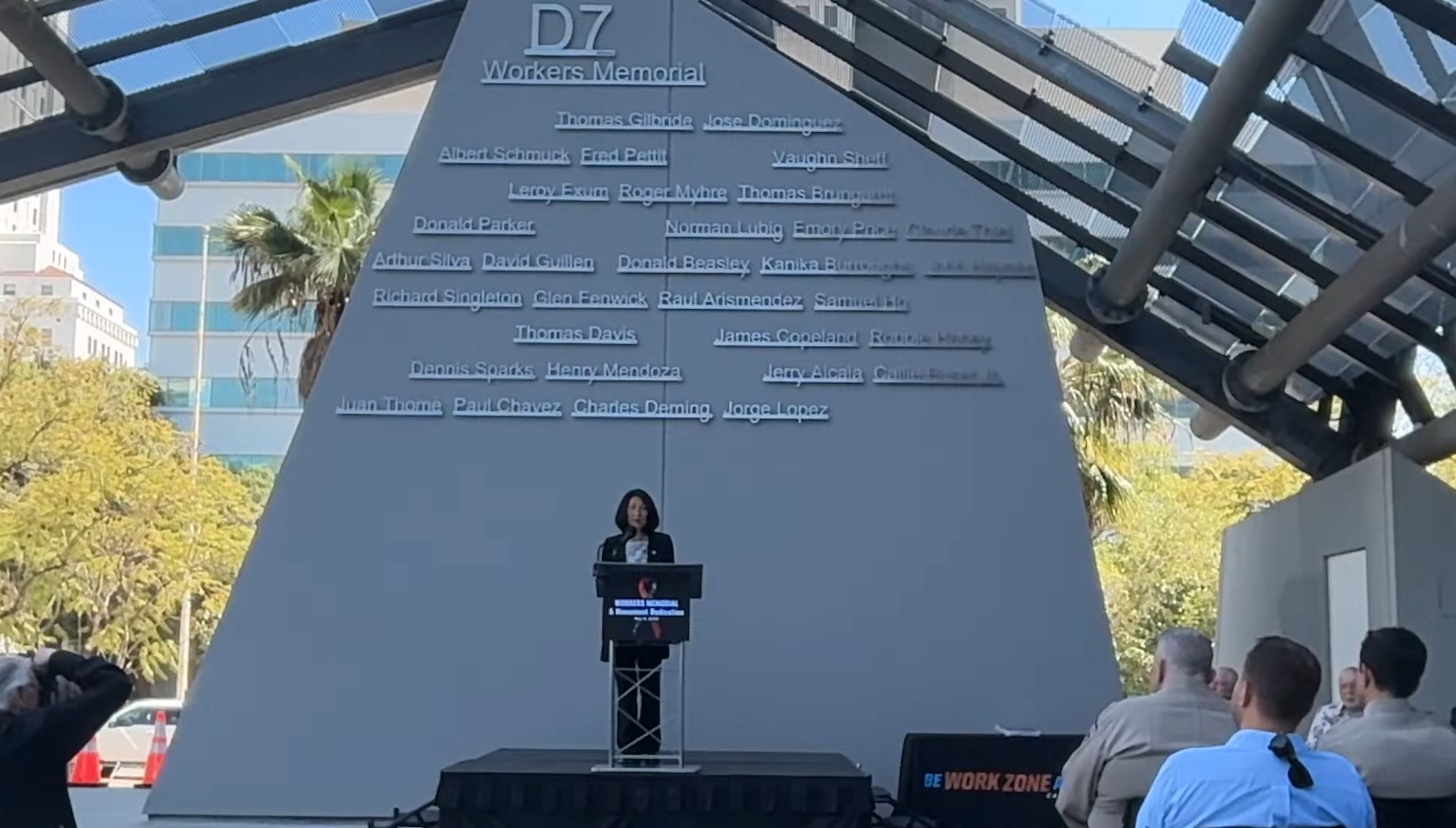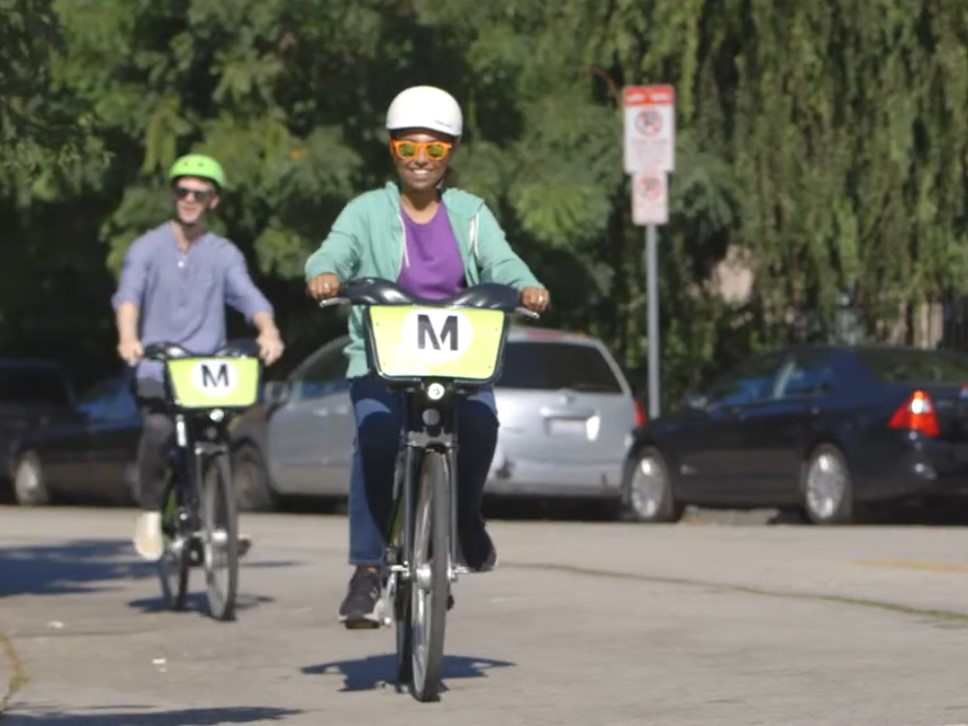
Yesterday afternoon, LADOT Senior Bicycle Coordinator Michelle Mowery and City Planning's Claire Bowen visited the Los Angeles City Council Transportation Committee to give an update on the City's progress on implementing the surprisingly progressive Bike Plan. You can read the entire report, here.
To nobody's surprise, the duo reported that everything is going according to plan. "We're actually ahead of schedule," Mowery replied to Committee Chair Bill Rosendahl when he asked how completion of the physical projects is going. "We have great support from the Mayor...We have good leadership from the Department. We're chasing more money than ever."
But almost everyone in the room had questions about the the Spring Street Green Buffered Bike Lane, and most of those questions had to do with the repeated problems of keeping the green on the ground. Atlantic Cities reported earlier this week that while the city has applied a second round of green paint to the street, that green paint is looking just as chipped and worn as it did before.
But Mowery thinks she has the culprit, and it's not just the rainy weather. "It looks like most of the paint is coming up on the concrete surfaces, not the asphalt," Mowery reported. In other cities with Green Lanes, such as New York and Chicago, more of the roads are asphalt. In L.A., the roads are a mix, and for whatever reason the concrete road isn't holding the green as well.
So what's the solution? Mowery and Bowin gave two possibilities.
The first is to find something green that sticks to asphalt better that the green paint, such as the thermoplast used for L.A.'s other green lane on 1st Street in Boyle Heights. The 1st Street green lanes uses the more expensive thermopast, applied with applicators and blowtorches, but only uses them in conflict zones where cars and bikes have the greatest interaction, such as intersections or car parking areas. This leads to using less and more expensive ground markings.
Councilman Paul Koretz, after praising the Spring Street Buffered Bike Lane for bringing more cyclists to Spring Street than he would have believed previously, went on to question LADOT about the beat up paint. "I don't understand the problem. As long as I remember we've been painting white on asphalt, concrete everywhere on the street." Mowery responded that much of what people believe is paint is really the more expensive, and more sticky, thermoplast.
The second option to fix the paint job on Spring Street is to wait to apply a third coat until the weather, the street, and everything else is dryer. LADOT originally pinned the shoddy condition of the newly painted lane on the rain, and that answer does hold some truth. But does the city really want to wait half a year to fix up the road on what is essentially a pilot project? That remains to be seen.
Despite the concerns, the Council Members in the room, Rosendahl, Koretz and Jose Huizar, who represents the area of 1st Street in Boyle Heights that has the other green lanes, all wanted to know when the city was going to get more. Neither LADOT or Planning were willing to commit to a timeline.
When it was time for the public to comment, the tepid support expressed to the Daily News on Monday gave way to a more positive response from the Los Angeles County Bike Coalition's Alexis Lantz and Jay Slater, the Chair of the City's Bicycle Advisory Committee.
Lantz used the word "excited" multiple times to express support for what the city is trying to do to advance cycling during her testimony. She did have one caveat, and it concerned Mayor Villaraigosa's pledge to bring 40 miles of completed bicycle projects to the city every year.
Lantz noted that the LADOT's weekend of Sharrows, where they placed over 20 miles of Sharrows in 48 hours throughout the city, should not completely count towards the Villaragisosa's promise. After all, some of the streets that now sport the thermoplast chevron are slated to have bike lanes or be bicycle friendly streets at some point in the future. Just placing Sharrows doesn't complete these projects, so they shouldn't count.
The city has been accused of using the 20 miles of new Sharrows to pad their stats on bicycle project milesage, including a scathing critique from Streetsblog contributor and Board Member Joe Linton, but yesterday there was only support for Sharrows and the city's plans for the infrastructure tool.
"Sharrows are not a replacement for a bike lane," began Slater. "If we got the time and we got the space and we got the money...If we can get them down, and we can have a bike facility in place, then I vote 'yes' on every attempt to get them that we can."
Rather than poke at the city for any perceived issues with implementation, Slater took aim at un-named City Council offices for not giving political support to their representatives to the Bicycle Advisory Comittee or taking time to respond to Slater's request for meetings. When Rosendahl pushed the BAC Chair to get him the names and he would talk to the Councilmen directly, Slater said he would talk "offline."
But one Councilman was singled out for a black hat was Tom LaBonge, who Slater claimed undercutted work done to make the "4th Street Bike Boulevard" a reality. While LADOT, LACBC and LABAC staff and volunteers were trying to explain and sell the importance of bicycle signals at certain dangerous intersections, LaBonge announced at a community meeting that he was pulling support for the signals. LaBonge was replaced on the Transportation Committee by Huizar when the Council reshuffled committee assignments in July and was not present to defend himself.
So what's next for the Bike Plan projects? LADOT didn't mention anything particular project by name, but did mention that there are over 4 miles of projects ready to go on the ground, another 11 and three quarters in the environmental review stage and over forty in some sort of design.
The city's environmental review for bicycle projects that would require removing a lane of traffic in a high-car volume area will not be completed until after this fiscal year (i.e. July 2012 bat the earliest). What that means for the city's plan to create 40 miles of completed bike projects in the 2013 fiscal year was not addressed, but looms large as we approach the end of the current calendar year.





